Today’s review is about the all new Burson Conductor 3X aka the C3X, a fully balanced DAC/Amp and ADC that retails for $2,144 USD.
Disclaimer: Burson Audio supplied the Conductor 3X at no cost for this review. This article represents solely my own impressions. Burson Audio is a site advertiser but in no way affiliated with Headfonia. Many thanks for the opportunity and generosity.
[responsivevoice_button]
About Burson Audio:
Burson Audio is a Melbourne based manufacturer of D/A Converters, Amplifiers and DAC/Amps. They have been active for over 20 years (since 1996) now, and are probably best known for their good price to performance products. We have covered many of them on our web space in the past, and if you want to check out previous reviews you can do so here: www.headfonia.com/tags/burson
Burson works on a couple of different technologies. Their most popular one might be their discrete op-amps for which they give a life-time warranty. Burson also introduced a so-called max current power-supply and their cool case. You can dig deeper into what these exactly are on their website.
Their product range goes from the $199 USD Fun all the way up to the $2,144 USD Conductor 3X. Burson has something for every wallet-size in their portfolio and even offers upgrade components for those that want to tinker a little.
Another good thing about Burson is, that they have a wide-spread dealer network all around the globe. So, if you want a try-out session you can check their dealer-list online and go to the nearest available one. Why do I mention this? Because it isn’t always guaranteed that there is a retailer nearby in our hobby.
Conductor 3
This review is about the Conductor 3X, you can find the regular Conductor 3’s review right here:
About the Conductor 3X:
The Conductor 3X is a fully balanced, Class A, discrete digital to analogue converter and amplifier. It uses a dual mono construction built around the ESS 9038Q2M chips and their own V6 Vivid Dual op-amps. It comes with four digital inputs. Namely USB C, RCA Coax, S/PDIF optical and Bluetooth 5 (aptX HD).
The C3X decodes PCM up to 32bit and 768kHz and DSD up to DSD512 via DoP. On top of that there is also a 3.5 mm microphone input, should you want to record with the Burson. You can use the C3X as a headphone or pre-amp solo as well, bypassing the internal DAC via the XLR inputs. You get two of them, so you can hook up two separate sources if you need to.
Output-wise the Conductor 3X offers a line-level XLR and a pre-amp XLR output on the rear. On the front you’ll find a 6.35 mm and a 4-pin XLR headphone port. Both these headphone outs come with an impedance of 0.5 Ohms, which is really low and should not mess with low-impedance headphones.
The C3X is quite a beast when we’re looking at power specs. The unbalanced 6.35 mm output boasts 3.75 Watts into 16 Ohms, while the balanced 4-pin XLR even doubles that. This means, that the Burson should not have any problem with even the most demanding headphones out there. And I can confirm that it drives my Susvara to blasting volumes. But loudness is not everything as we know.
The Conductor 3X measures 255 x 270 x 70 mm (DxWxH) and weighs approximately five kilograms. More detailed specifications can be found on the product page here: https://www.bursonaudio.com/products/conductor-3x/
Burson gives the Conductor 3X with a two year warranty.
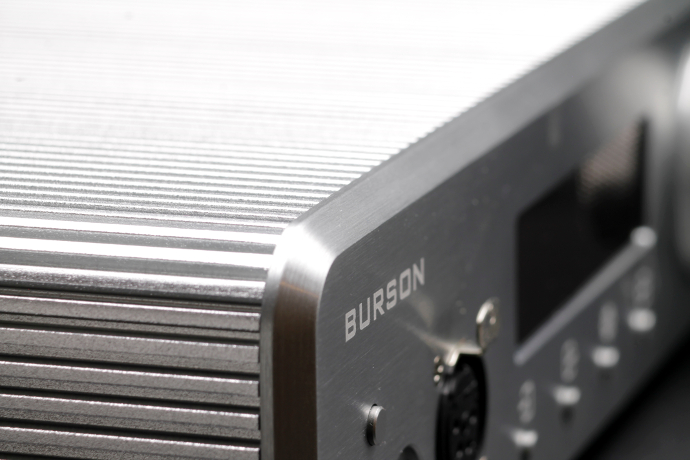
Burson Conductor 3X
Package:
The Conductor 3X comes in a big glossy cardboard box. The C3X is placed safely in the box and surrounded by hardened foam. Together with the unit comes an external power supply suitable for your country, as well as a USB C cable to connect to your computer. My unit didn’t come with a warranty card or printed manual.
A pdf version of the manual as well as the Windows drivers can be downloaded here: https://www.bursonaudio.com/downloads/
Burson ships the Conductor 3X with a very nice and small metal remote control. With which you can change inputs and control volume. Unfortunately you can’t switch outputs or turn off the C3X with it. Personally I’m really missing those two buttons.
In the package you will also find a torx screw driver and a USB C to USB A adapter. The screw driver is for when you want to go nuts and start op-amp rolling. For that you simply have to take out the four screws on the bottom of the case and lift the top. Now you have access to the entire printed circuit board.
Worth noting is, that the supplied white USB C cable did not work with the Conductor 3X. I did get a second cable by Burson though, which had no issues. As far as I understand, the black cable is what will get supplied with retail units.
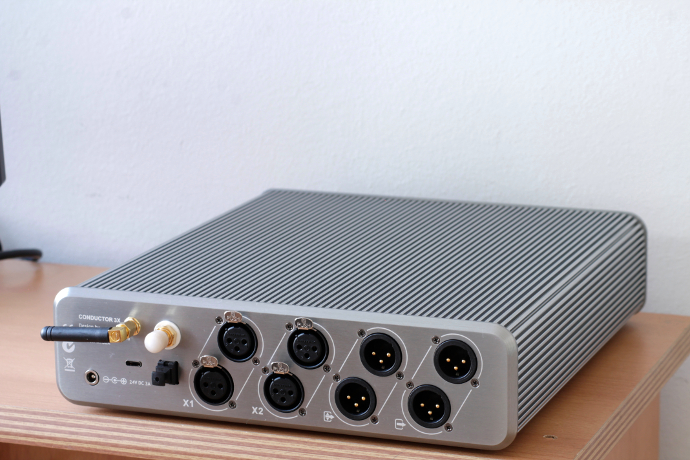
Burson Conductor 3X
Build Quality:
The Conductor 3X is extremely well built in my opinion. Its full aluminium frame gives a very solid impression and with Burson’s cool case it also runs moderately warm during operation. Since this is still a discrete Class A circuit it warms up, but it doesn’t get as hot as other comparable gear I’ve handled.
The front plate holds quite a few buttons and outputs, as well as the centered screen. On the screen you can see which in- and output are used as well as file format (sampling-rate) information. Let’s go over the button and connector layout.
From left to right you have microphone input, power button (above mic-in), 6.35 mm and 4-pin XLR headphone outputs. Below the screen you have buttons for input and output selection, settings and screen-rotation. On the far-right you have the 360° clickable, rotary volume control. Since the volume knob can be clicked, it doesn’t sit 100% fixed and can be moved a bit. In the end it’s still well made in my opinion.
On the rear you will find the power input, Bluetooth antenna and USB C socket. Next to them are RCA Coax and optical inputs as well as two XLR ins, followed by the adjustable pre-amp output and the fixed line level DAC output. One thing that is not clearly stated on the rear is where left and right channels go. I’ve tested this out and found that the right channel is on bottom, while left channel has to be connected to the top XLR socket.
Something that bothers me about the appearance of the C3X is the 4-pin XLR connector on front. I’d have opted for one that doesn’t have to be screwed into the chassis and one that doesn’t come with the push button to release the plug. I find don’t find the solution of Burson visually appealing, but that’s just me. Although I get why they chose the screw-able design, as it does offer higher stability and support.
The review goes on on page two!






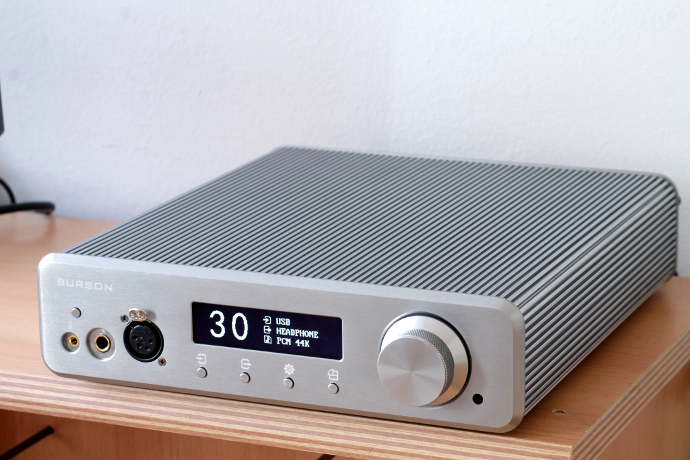
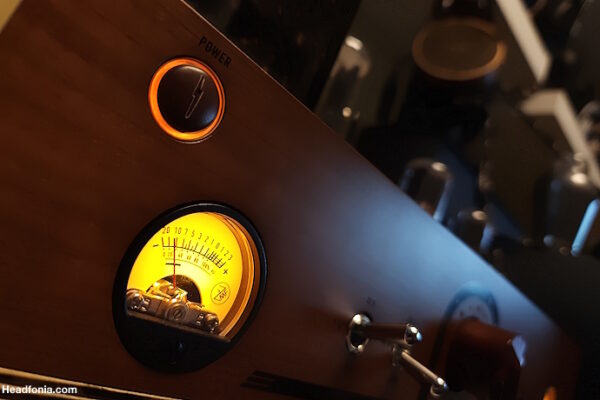
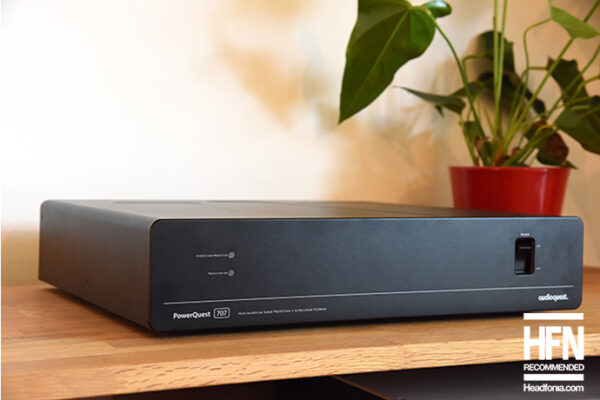
Arturo C.
Awesome post, thanks you so much for sharing, you should also visit http://techdevices.review/category/headphone-review perhaps cause this site is great for headphone stuffs said leslie just above.
David
Great review! Did you get a chance to use the DAC as a preamp into an amp? I’m curious as to how it will work w/ my system. I have a pair of Wyred for Sound mAmps which only need 1.3v to drive them to full output. They’re very passive friendly but I’m afraid the C3X volume would have to be turned down so much that I would be throwing away bits in order to get the volume to tolerable levels. This has always been one of my fears w/ digital volume controls. I’m assuming the low gain option is only for the headphones? Thanks for any help you can give.
Victor
When I use the 3XR as an amp with an external DAC through XLR input 1/2, the sound is out of phase (reverse polarity?). Does your unit have this issue with the XLR inputs? I don’t think it’s wiring problem but the firmware issue of the amp.
Dario
Will you chose the Burson , V590, or Formula S to drive the Abyss Phi?
Too many choices and cannot test anything because of COVID!
Willem
Hi guys
In the 3X Performance review you did give a slight edge to the Questyle CMA Twelve I believe. So how would you rate the 3X Reference compared to the Questyle CMA Twelve Master? Both the higher end alternatives to their lower tiered siblings..
Cheers Willem